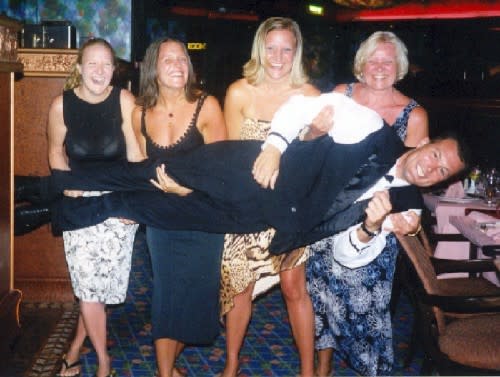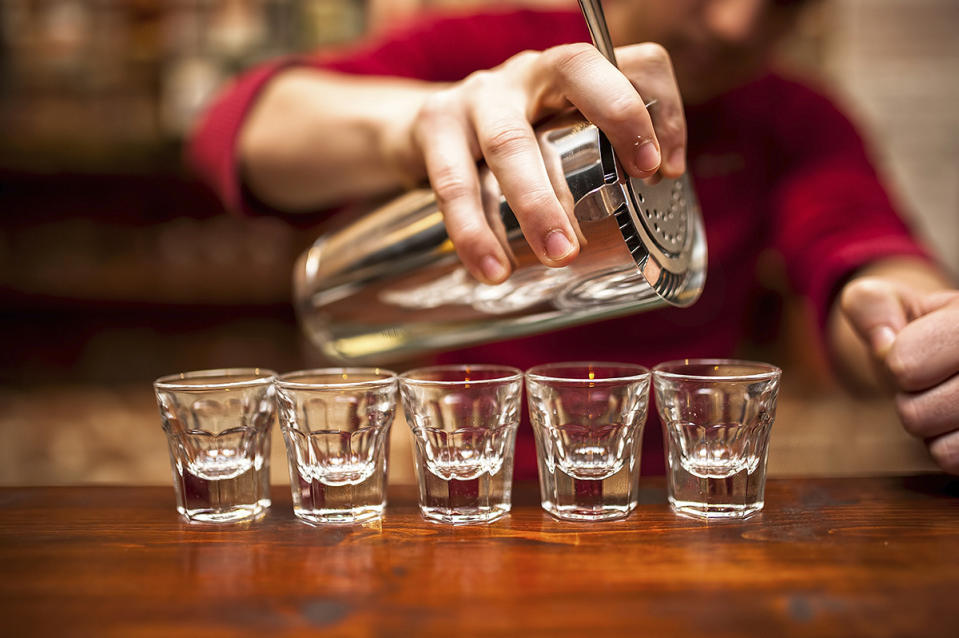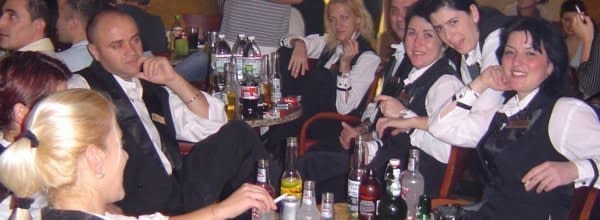Kitchen Confidential: Confessions of a Cruise Ship Waiter
On cruise vacations, eating is an integral part of the experience. Good cruises are measured mostly by the cuisine; that’s often the first thing cruisers are asked after a trip: “How was the food?”
So when you’re talking about the quality of the cruise — the very part that passengers go home and brag about to their friends — the waiters, the cooks, and other food service workers have almost as big a responsibility for the success of the cruise as the guys on the bridge making sure the ship doesn’t hit an iceberg.
“I spent four years working on cruise ships and I worked on, I believe, six different cruise lines,” says Brian David “B.D.” Bruns, a former cruise ship crew member and author of Cruise Confidential, a series of books based on his life at sea. “I started out as a waiter in the restaurant.”
Frequent cruisers see only the posh, ice-sculpture grandeur of the dining rooms, or maybe the quick-with-a-smile efficiency of the servers in the buffet areas. But behind the scenes, Bruns’s experience as a cruise ship waiter was decidedly less glamorous.

What it’s really like being a waiter on a cruise ship. (Photo: Randy Faris/Corbis)
“The cruise lines are absolutely sweatshops,” he says. “Make no mistake about it; they are sweatshops.”
Now, Bruns is revealing to Yahoo Travel the rigors of being a cruise ship waiter, what goes on in the kitchen (or “the galley,” as it’s called) and the intense, behind-the-scenes culinary drama that would make Gordon Ramsay cry like a baby.

B.D. Bruns, a former cruise waiter, dishes to Yahoo Travel about what really goes on behind the scenes on a ship (and it’s not all good). In this photo, he gets a lift from passengers during his days as a cruise ship waiter. (Photo: B.D. Bruns)
Cruise ship waiters work extremely hard
“I had to work a minimum of 80 hours a week,” Bruns says. “I frequently worked 100 hours a week. In fact, when I was on Carnival Legend, I worked 15 weeks in a row at a hundred hours a week and then I stopped counting. The sheer amount of work is crazy!”
He says since his days at sea, the cruise lines have clamped down on the hours — publicly, at least. “They make a big show of how nobody works over 80 hours anymore, which is total BS,” he says. “Whatever. Thirty percent of my duties were off the clock anyway. But if I didn’t do it, I couldn’t perform my job.”
Related: Ships Have Padded Cells for Problem Passengers and Other Confessions of a Cruise Security Officer
And just like waiters on land, Bruns wasn’t making a lot of money. “You’re doing that for less than minimum wage,” he says. “And they literally will tell you when you can go to the bathroom or not. We have rules against that here in the States, but in international waters, anything goes.”
As bad as waiters had it, Bruns says the cooks may have had it worse. “If you become a chef on a ship, you sign on one day, and eight months later you see the sun again the day you walk off the ship,” he says. “These guys work all day, every day, seven days a week. They never get a break. Never. These guys never get off the ship.”
Could your waiter be drunk?

“We’ll just call these a nightcap.” (Photo: iStock)
How did waiters cope with such grueling work conditions? Bruns says he self-medicated with a method he calls “drunk working.”
“You just got off your shift, you’re all stressed, you worked really hard, it’s like you just came off the front line,” he says. “And you’ve got six hours before you have to be right back in the damned dining room. What do you do? You hammer shots so you pass out ASAP. This goes on seven days a week for 10 months. You start hammering those shots so it will put you to sleep faster. And when you do that, after a couple of months, it takes more than a couple of shots to get you drunk.”
Despite the fact that just about every sleep expert around says drinking actually prevents sleep, Bruns says he remembers plenty of waiters using booze as a sleep aid. “The cruise lines have taken efforts to curb that,” he says. “They no longer give away free booze like they used to in the crew bar, but they still have cheap booze.”
It’s like ‘Hunger Games’ in the dining hall

You may see a cruise ship dining hall, but waiters see a battlefield. (Photo: Ingo Wagner/epa/Corbis)
Think about this the next time you drop your fork in a cruise ship dining room and you ask the waiter for another one. Bruns says silverware, cups, and glasses were a valuable commodity on the cruise ships he’s worked, with waiters forced to steal these items from each other, all because of a cruise line policy.
“In their effort to control breakage, [the cruise line] would have exactly 10 percent less coffee cups than they need,” he says. “The company intentionally did that because if they had plenty of coffee cups, every time [a waiter] would break one, he’d say, ‘Ah, who cares?’ So Carnival put it right back on the waiters and made these cups precious.”
Related: Confessions of a Cruise Ship Doctor
As a result, Bruns says waiters were pinching from other stations to get stuff for their diners. “You actually have to go in early to steal menus, to steal silverware, to steal plates, to make sure that your guests have it,” he says. “It’s total scavenging; you lie, cheat, and steal. And to make a go of it, different waiters will form pacts, usually around their nationality. We call them mafias. There would be the Romanian mafia, there’d be the Filipino mafia. It was just like that.”
The galley is a war zone

Getting those entrées out to guests can be a cutthroat business. (Photo: National Geographic Creative/Alamy Stock Photo)
If you think it’s a free-for-all in the dining area, you should see what goes on in the kitchen. “The chaos is crazy,” Bruns says. “You’re waiting in line and waiters have to outmaneuver other waiters just to get enough forks. So what do you think they’re going to do when their guest is like, ‘Could I please have another entrée?’ So waiters start stealing entrées from each other and cutting in line. I don’t want to say getting into fights, but there are a lot of elbows thrown.”
Unlike the pleasant public face people put on in front of passengers in the dining hall, Bruns says things in the galley get raw — especially the language. “Believe me, down there it’s a frigging war zone and [the chefs] don’t care because no one can hear them,” Bruns remembers. “The amount of profanity that goes on in the kitchen between waiters and chefs. Wow! It is nasty — nasty, nasty, nasty. There’s no holds barred.”
Bruns says with the intense pressure and the dozens of nationalities represented in the kitchen, you’re not going to see a lot of political correctness. “When you have 60 nationalities and every religion and every color of human, they just go right at it,” he says. “Whatever it is that’s different between you and me, they target it. There were a few British waiters, and believe me did they get an earful from the Indian chefs, you know, because of history, right? And the chefs would turn to me and assume I’m English, because white people are very rare down below on the ships, and start swearing at me. I’d be like, ‘Hey I’m American! I didn’t do anything!’ And they’d be like, ‘Yeah, but you bombed him, and him, and him, and him! So, no, you don’t get any f—ing hash browns!’ ”
Although Bruns remembers the galley as a “free-for-all mosh pit of hate,” he also remembers it as hilarious. “It really is quite comical if you can separate yourself from it,” he says. “As insulting as it is, the edge is definitely taken off because it’s humorous. Everybody knows we’re venting. It’s connection; it’s not a barrier because humor is the connection. You get that on the ship.You embrace that stuff and I loved it.”
Yes, they talk about passengers

Bruns’s fellow crew members unwind (and maybe talk about passengers) at the crew bar. (Photo: B.D. Bruns)
Bruns says that the un-PC venting the dining room staff directs at each other, they direct toward the passengers too — when they’re out of earshot, of course.
“All these guys from India and Indonesia and the Philippines — these guys are fully adult men that weigh 130 pounds,” he says. “And they’re like, ‘Good God: look at how fat all you Americans are!’ When I went to the crew bar and they first saw me, they assumed I was Canadian and they’d be making fun of Americans.”
Bruns says one thing in particular that vexed his foreign-born mates was the lack of geography knowledge exhibited by some of the passengers when the waiters introduced themselves. “[The waiter] is like, ‘Hi, my name is ‘Blah blah’ and I’m from the Philippines.’ And the passengers would say, ‘Oh, where’s that?’ or ‘I’m from Indonesia.’ ‘Where’s that?’ ”
Related: Shocking Video Shows Man Going Overboard on Cruise Ship
Bruns remembers one time in the 1990s, a waitress from Bosnia introduced herself to a table of American passengers. “She was like, ‘I’m from Bosnia.’ I was there; I heard it: this guest was like, ‘Where is that?’ And she said, ‘You bombed us three years ago and you don’t know where we are?’ One of the other waiters saw that and was giving her the signal like, ‘Zip it! Zip it!’ That one really pissed her off.”
Food for the crew

The delicious food served to guests on cruises often isn’t available to the crew. (Photo: Jan Butchofsky / Alamy Stock Photo)
This is surprising: Bruns says the honey-glazed salmon, the tuna tartare, the baked Alaska, and other items you may find on the cruise ship menu generally aren’t served to much of the crew.
“The crew does not eat leftover food that’s given to guests,” he reveals. “They don’t get to hit the buffet after the guests are gone. It’s cheaper for the cruise lines to feed the crew separately, especially because they give crap to the crew.”
Bruns says not all cruise lines were like that. “It depends on the cruise line,” he says. “Some are better than others. Carnival actually did a good job feeding the crew. Carnival takes better care of their crew than any other cruise line. They work ’em really hard, but they give them perks like lots of food and not too bad of quality.”
Related: The Worst People You Meet on a Cruise
But other lines, he says, were less generous with the food they give to the crew. “7-Eleven-quality hot dogs and hamburgers that are sitting under a heat lamp for 10 hours” is how Bruns describes the fare on his old ships; “mounds of white rice.”
Bruns says that diet presented a particular problem for the cruise ship dancers and singers, who were under pressure to be fit. “They’re like, ‘You don’t have any fresh produce. I can’t stay thin on this crap.’ So the singers and dancers have been allowed to eat guest food nowadays.”
The bright side

Hard work, questionable food, and abuse from the kitchen — all worth life on the sea. (Illustration: iStock)
It wasn’t all bad for Bruns. Overall, he remembers his four years on a cruise ship as “wonderful” (thanks mostly to what the hard-partying members of the crew did to unwind).
Still, he remembers life as a cruise ship waiter as an incredibly tough gig he stuck out longer than most of the others did, especially the Americans. So why did he stick it out? “I only did it because I was chasing a woman,” he says. “I would never have stayed for any other reason. That was the only way I could be with her, so I toughed it out.”
So if you’re on a cruise, be nice to your servers. They have a tough job. They might be catching grief from the other servers. And they might be doing the job for love.
WATCH: Sky Diving, Surfing: Is This the Most Over-the-Top Cruise Ship?
Let Yahoo Travel inspire you every day. Hang out with us on Facebook, Twitter, Instagram, and Pinterest. Check out our original adventure travel series, “A Broad Abroad.”

